“If you wear a dress and have an animal sidekick, you’re a princess.”
“Sometimes the world seems against you/the journey may leave a scar/but scars can heal and reveal just/who you are….”
Exact numbers are hard to come by, but certainly, since its introduction in the early 2000s, the Disney Princess franchise has been one of Disney’s most valuable properties, currently behind only Star Wars, the Marvel Universe and Winnie-the-Pooh in terms of revenue and popularity. The line includes not just films and videos featuring adorable princesses, but also related merchandise ranging from toys to clothing to books to furniture and wall paint, not to mention various theme park and Disney Cruise Line attractions. It was therefore nearly inevitable that just a few years after Frozen—a film so successful that it ended up spawning its own franchise and never becoming a Disney Princess film at all—Disney would find itself back into Princess territory again. This time, out in the Pacific Ocean.
Spoilers ahead.
A couple of disclosures before we get going. First, since I can’t see 3D effects, I saw this film in 2D. I can say that—apart from a few scenes here and there clearly designed to take advantage of the 3D process—the film works just fine in 2D, but it’s possible I missed some nuances or animation effects here and there. Second, I watched Moana in an audience filled with small, very excited and very noisy viewers, half left in tears just from the Cars 3 trailer (really, Pixar?) and half upset because they wanted to see Trolls or Fantastic Beasts and Where to Find Them instead. Which is to say, things did not start out well, and that “not well” meant that I missed some early moments and dialogue.
By the end, every small viewer was completely enthralled and wanted to see the film again.
I should also disclose right now that apart from one long ago trip to Hawai’i and a vague memory of hearing that taking lava rocks from Hawai’i brings bad luck, my knowledge of Polynesian culture can be summed up with the phrase “none whatsoever,” and I am considerably more familiar with Atlantic marine biology/species than Pacific species—though I’m not entirely sure the animators were attempting to make any such distinction. (The dolphins, for instance, are pretty generic looking dolphins not apparently intended to be identified with any specific dolphin species.) So if you are looking for a post able to dive into either one of those issues, this is not that post.
To head their new film, Disney selected the two men arguably most responsible for spearheading a revived interest in Disney Princesses: John Musker and Ron Clements, who had been responsible for three of the eleven previous Disney Princess films: The Little Mermaid (1989), Aladdin (1992) and The Princess and the Frog (2009). They had also directed Disney’s greatest ever flop, Treasure Planet (2009) but in the past few months, Disney’s publicists have kindly overlooked this little detail, so we should as well. They also happened to find themselves completely free, since their attempt to adapt a Terry Pratchett novel had run into the tiny issue of not actually getting the film rights for said novel, so they had the time to focus on another Disney Princess film attached to the sea.
Chief Creative Officer John Lasseter liked the general idea of a Pacific Islands inspired film, but urged both Musker and Clements to do more research into Pacific cultures in order to shape the story. This meant, as the two admitted with just a hint of embarrassment in later interviews, several journeys to various South Pacific islands, accompanied by Disney photographers shaping the now inevitable The Making of Moana featurette for the forthcoming Blu-Ray. (Some of these clips, released as part of the promotional tour, are available on YouTube and on ABC and NBC websites.)
Musker and Clements later said that the trip changed the story “tremendously,” inspiring them to stay closer to Polynesian culture than they had with most of their other films. Along with including elements inspired by their South Pacific tour, they hired a part-Polynesian story artist, David Derrick, who put a rubbing of his ancestors’ gravesites over his desk for inspiration, and hired native choreographers to help animators create some of the film’s dance sequences. Hawai’ian screenwriters Aaron and Jordan Kandell were brought in to help out with what was now becoming an almost inevitable discovery of major story problems just as the film was rushing to completion.
In further deference to the film’s Polynesian roots, Disney largely hired voice actors with Polynesian roots, including part Somoan Dwayne Johnson/The Rock; part Maori/New Zealander Rachel House; part Maori/New Zealander Temuera Morrison (probably best known to most of you as Jango Fett from Star Wars); part Maori/New Zealander Jemaine Clement; part Hawai’ian singer Nicole Scherzinger (oddly, given her background, for a role that included only limited singing) and, after a long worldwide search, debut actress and Native Hawai’ian Auli’i Cravalho, at 14 among the younger voice actors for Disney protagonists.
Sidenote: Also available on YouTube: a few completely adorable vids of Auli’i Cravalho recording her dialogue and Dwayne Johnson going around taking selfies, as you do.
Disney filled out their mostly Polynesian cast with three non-Polynesian voices in small roles: Christopher Jackson, who originated the role of George Washington in Hamilton, brought over in part by Lin-Manuel Miranda to perform some of the musical bits; Lin-Manuel Miranda himself, who jumps into one of the songs, and Alan Tudyk, by now a near Disney tradition, for the voices of Hei Hei the rooster and a villager.
To add a touch of authenticity to the soundtrack, Disney pulled in Te Vaka, a group of South Pacific musicians founded and led by singer/songwriter Opetaia Foa’i, to work with songwriter Lin-Manuel Miranda and composer Mark Mancina. This was before Lin-Manuel Miranda had vaulted to fame through Hamilton, though it’s not particularly difficult to notice his touch on quite a few songs here, particularly in “Where You Are,” and “Shiny.” Mancina had collaborated on several Disney projects previously, most notably on Tarzan (1999) and the Broadway version of The Lion King.
If none of the songs here are as immediately earwormy as Frozen’s “Let It Go,” or quite up to the very best songs of The Little Mermaid (1989), Beauty and the Beast (1991) and The Lion King (1994) most are catchy, with “We Know the Way,” probably a particular highlight. Not just because if you listen very carefully, you can hear Lin-Manuel Miranda joining in, but because of the spectacular animation for the piece. Also visually spectacular, if feeling more than a bit out of place, is “Shiny,” sung mostly by Jermaine Clement, which ends in something rather new for Disney animation: neon, and a lot of it, against a black background. Disney had worked with brilliant colors against black backgrounds before, of course, and quite a bit of this segment feels like the now almost traditional nod back to the “Pink Elephants” sequence in Dumbo (1941) but Disney had never used quite this much neon before, and quite possibly should never do so again.
The other standout is “You’re Welcome.” Not because it’s the best or most inspiring song of the bunch, or because of Dwayne Johnson’s singing voice, which can be best and most kindly described as “on pitch”—despite a bit of personal direction from Lin-Manuel Miranda (available on YouTube)—but again, because of the visuals: this is the sequence that introduces Maui’s ever shifting, hand animated tattoos, one of the highlights of the film.
Which brings me to the animation, arguably the most beautiful and spectacular of any Disney film since John Lasseter took over the Disney Animation Studios, starting the so-called “Revival” period, beginning more or less with the releases of Bolt (2008) and The Princess and the Frog (2009). Like most of the Disney animated features of this period, Moana mostly features lush, brilliantly colored computer animation, with one exception: those tattoos, animated by hand by Eric Goldberg, who you might remember as the lead animator for the Genie from Aladdin (1992) and Phil from Hercules (1997), as well as the guy pretty much single-handedly responsible for drawing, by hand, the “Carnival of the Animals” segment of Fantasia 2000, i.e., “the bit with the flamingo and the yo-yo.” Goldberg also directed the highly stylized Rhapsody in Blue segment, which mimicked the look of Al Hirschfield’s cartoons for Fantasia 2000.
Goldberg brought those same skills to Moana, creating highly stylized, sentient cartoon characters, with a two dimensional look, mimicking both the two dimensional look of tattoos and some elements of South Pacific art. As with many of Goldberg’s previous creations, the tattoo characters never speak, but manage to make their feelings quite clear through pantomime. It’s not just beautifully—and amusingly— done, but adds a touch of hand art to a computer animated work—a neat contrast to the very first film Musker and Clements directed for Disney, The Great Mouse Detective (1986), which added a touch of computer animation to hand art.
That computer art, and in particular the background art, is impressive too, with artists taking advantage of the medium to create detailed, animated backgrounds, and artfully rendered lighting developed for Big Hero 6 (2014). Check out, for instance, the finely detailed art work on the sails of the outrigger sailing canoes—and then note the way the shadows and reflections move across those sails and the art, as the sails shift in the wind, a level of lighting work and detail Disney artists had rarely achieved even in the computer animation period, and not achieved in any of the hand animated films except for Pinocchio (1940), Fantasia (1940) and one or two scenes in Sleeping Beauty (1959).
I should also note the spectacular water effects, ranging from the multiple underwater shots in different lights (something the directors had learned a little about back in their The Little Mermaid (1989) days, various images of waves and waters, and waterfalls that look more like actual falling water than anything Disney animators had previously achieved. My favorite shot, in fact, is a throwaway—a half second, if that, of the outrigger canoes moving across a moonlit sea as a shooting star whizzes by above; for sheer beauty, it may be one of the most beautiful images Disney had created since Fantasia. It took decades, but Disney had finally achieved something it had been trying for since the 1930s: a moving painting—computer generated, but still a painting—of realistic looking, moving water.
Not everything reached that pinnacle of success. In particular, most of the characters, except the chicken, the pig and, more arguably, Maui, continue to sport the rather rubbery skin look of so many computer animated characters, occasionally giving them the look of little toys running through paintings. Which, come to think of it, may have been part of the point, at least from the point of view of the Disney merchandise division. And it’s not entirely a bad thing: the rounded, still cartoonish figures help to keep a sense of fun and lightness in what could have been a very dark film about the fear of disappointing your parents and approaching environmental destruction.
Though the character designs and concepts for Moana and Maui, in particular, seemed less designed to keep the film on a light note, and more specifically designed to counter criticisms of previous Disney Princesses. Thus, unlike most of her predecessors, Moana is not unnaturally skinny, and, although she does go bare bellied (a sensible decision given that she spends pretty much all of her time either wandering around under the sun or swimming in the ocean), the animators avoided giving her the same sexualized look as equally bare bellied Princess Jasmine or, for that matter, Ariel.
Maui, in turn, was designed largely to be big enough to let Eric Goldberg tell stories on his skin, but also to look unlike most of Disney’s previous princes (and Kristoff). That different design helps signal that the relationship between Moana and Maui will not be romantic, but rather shift between antagonistic to helpful to, well, something that’s almost friendship, if Maui continues to work on his attitude a bit.
Having now gone through a number of Disney films that also lack this sort of romance, I didn’t find this quite as innovative or surprising as several critics apparently did. Indeed, the lack of romance has been a feature of several films from the Revival period, including Bolt (2008), Winnie the Pooh (2011), Big Hero 6 (2014) and Zootopia (2016)—and even arguably Wreck-It Ralph (2012), which does have a romance, if a decidedly secondary one. Like all of those characters, Moana just has far too many things to do right now. But that said, if we ignore Brave, made by Pixar, not Disney, Moana is the first Disney Princess film (or potential Disney Princess film) to not feature a love interest, which I guess does make it stand out a bit. Assuming, of course, that Disney does listen to Maui’s description of Disney Princesses and decides to elevate Moana to that official status.
Not that Moana completely abandons several other familiar Disney princess themes. As in many of them, Moana starts her film trapped in a small geographical location, in this case a fictional island in the middle of the Pacific. As with nearly all of them, Moana wants to do something else, something more, even though, as with about half of them, her parental figures (and a few others) believe that she has everything she needs, including coconuts and fish, and that happiness can be found where you are. This being a Disney film, they naturally sing a song about this.
I gotta be honest here: After going through the entire Disney canon, I found myself getting a bit restless here, desperately longing for a reverse of this—that is, a Disney protagonist/princess surrounded by characters eager to explore and break boundaries and change EVERYTHING, with the protagonist leaping up and saying, WHAT? ARE YOU KIDDING ME? I LOVE THE STATUS QUO!!!! IT’S GREAT! STOP TRYING TO CHANGE THINGS!
Moana is not, alas, that status quo seeking protagonist. Like the majority of Disney Princesses (and most Disney protagonists), she feels she could—and should—have more out of life. Moana is most definitely not Ariel—she loves her home, and accepts that she’s responsible for helping to take care of it and guide its people—but she also can’t stop hearing the call of the sea. In one of the film’s most heartbreaking moments, she asks, “What is wrong with me?” The answer is that she is special for a number of reasons—her personality, her determination, her courage, her heart—and as the film recognizes, that can be difficult.
In her case, however, those reasons turn out to be literal lifesavers, since Moana’s island home is facing a severe crisis: declines in both coconut production and fish stocks, putting the population of the entire island at risk. Interestingly, Moana chooses to depict the ongoing issues with the coconut plantations and depleting fish stocks not as the result of resource deprivation and potential overpopulation, but as a curse brought on through outside factors—in this case, an angry goddess. And also interestingly, Moana suggests that instead of trying new or environmentally friendly/sustainable approaches (go fish somewhere else while you let the fish stocks in the lagoon recover! plant another grove over there!), the best way to save the island environment is to return to the old methods of exploration, and find more islands to exploit.
This is perhaps the most troubling message of the film, and not just because it emphasizes using old, potentially more destructive methods, but also because it’s a message that diminishes environmental issues down to “magic,” something largely beyond human control, and suggests that only “magic” can restore the environment. It’s a logical follow-up, I suppose, to the weird insistence of The Lion King (1994) that prey animals are so delighted to be prey that they’ll participate in not one, but two musical numbers about it, or the rambling thoughts of Pocahontas (1995) about the colors of the wind, but it still makes me slightly uneasy. Especially since other methods are mentioned—briefly—but dismissed.
Add to this a scene where Moana BREAKS AND DESTROYS LIVING CORAL in order to escape, and well, I find myself deeply questioning why anyone is reading this film as particularly environmentally friendly. Sure, Moana contains moments that urge viewers to listen to the sea and the wind, and the strong implication that the ocean cannot heal itself without human intervention—but these are countered by strong suggestions that environmental destruction is caused by divine or magical forces, forces with their own intelligence and motives, and forces that humans cannot combat without divine assistance.
To be fair, Moana breaks the living coral well before she has her vision of her explorer ancestors and received the heart of the goddess Te Fiti, and breaks it right in the middle of disobeying her father’s “Don’t go beyond the reef” dictate, and as part of trying to save her pet pig—making that scene more of a “to avoid causing harm to the environment, obey boating rules” lesson, along with “to avoid causing harm to the environment, please do not let pigs fall into the ocean,” two lessons which I can only applaud. And Moana does unequivocally state that saving an island and turning it green again is worth the risk of disobeying your parents, facing glam crabs with high opinions of themselves, and facing coconut pirates. In other words, it’s worth risking your life to save the planet. Or at least your own little island.
Still, I can only repeat what I said on Twitter just minutes after watching the film: KIDS, DON’T DESTROY LIVING PILLAR CORAL. EVEN IF YOU SAW A DISNEY PRINCESS DO IT IN A MOVIE ONCE.
Other elements work much better, even things that really shouldn’t—for instance, the dimwitted rooster Hei Hei, who easily steals the show, and a narratively pointless bit involving some pirates made out of coconuts, which although apparently designed mostly to sell coconut-themed toys, does add an entertaining action sequence during what would otherwise be a lull in the film—and of course, gives a reason for Moana and Maui to bond.
Speaking of those coconuts, for the record, I don’t think the coconut pirates are just little people wearing coconut armor, as some critics have suggested. I think they’re actual animated coconuts, in the full sense of the word “animated,” If you look closely, they only have four fingers on each hand, for instance, which, CREEPY. Also they have armor on TOP of the coconuts. It’s a film with a demigod, a glam singing crab, a sentient island, the sentient ocean, and characters who inexplicably decide not to eat a chicken so dimwitted that he tries to eat rocks. I mean, yes, as a result this is one scrawny and presumably not all that tasty chicken, and keeping the chicken around ends up helping with a plot point, but still, yes, after all that, it’s really not that difficult to imagine coconuts coming to life and deciding to embrace a life of piracy.
And although next to all of this, not to mention the glam crab, little pig Pua kinda fades into the background, he, too, is adorable, and will undoubtedly be a very popular toy this Christmas, designed, as he is, to be ultra cuddly and cute.
But the heart of the film is not any of this, or even the antagonist/buddy/mentor relationship that Moana and Maui develop, but rather its center theme, redemption. Redemption for Maui, who, above all, wants to be loved and respected again (and to get his hook back); redemption for the ocean, who was unable to stop Maui from stealing the heart of Te Fiti, and above all, redemption for Moana, who just wants to be the perfect daughter, who gets to prove that yes, she is a worthy leader of her people, and that yes, she was right to follow the call of the sea. It’s not just touching, but more than a little bit inspiring, a message of hope and change.
As with Zootopia, I find myself questioning just how well Moana will endure, decades from now. Yes, it’s beautiful, and soaring, but it’s also chock-full of contemporary references and jokes, just as with two previous outings from Clements and Musker, Aladdin and Hercules. True, some of the jokes, including a bathroom joke that the small audience in my theatre LOVED—are fairly timeless, but others, particularly the ones directed at adults, like Maui’s Twitter comment—may not be. As I noted earlier in this reread, just twenty years have already left many of those Aladdin references fairly obscure. Hercules has worn a bit better—but I don’t think it’s a coincidence that Hercules is also one of the films that Disney has frequently chosen to release on Netflix, rather than save for the increasingly expensive but snatched up”Diamond” and “Platinum” and whatever marketing term Disney plans to use next big DVD/Blu-Ray editions. It’s not just these two films, either. As we’ve discussed, multiple jokes and references in earlier Disney films became incomprehensible over time.
Nor has Moana escaped criticisms of cultural insensitivity, despite Disney’s research and hiring of Pacific Islanders. At least some critics have voiced annoyance with the decision to portray the god Maui as an overweight jerk instead of a powerful, beneficial deity, and a number of consumers protested a Maui Halloween costume for small children which Disney quickly pulled from shelves.
But most critics adored the film, and for now, at least, Moana has been a box office smash. Disney has also launched the usual line of merchandise, including clothing (including adorable little pig slippers that, sadly, are available only for children, not grown-ups that need them, Disney!), coloring books, key chains, dolls, plush toys (including the coconut people, available in a plush set that I can only describe as “terrifying”), Christmas ornaments, pillows and a backpack that plays music from the soundtrack—something I can’t help but think that Walt Disney would have thoroughly approved of. Moana might not be an official Disney Princess yet, no matter what Maui and critics might say (we’ll see if Disney updates her status in the next couple of years) but she’s definitely one of their success stories. And a sign that, after decades of ups and downs, the Disney Animation Studio is back on track.
And with that, we’ve made it through the entire Disney canon. Thank you so much for coming along this journey with me.
See you next year, when we do a bit of a look back at the entire Disney Read-Watch, and introduce the next two read/watch projects!
Mari Ness lives in central Florida.










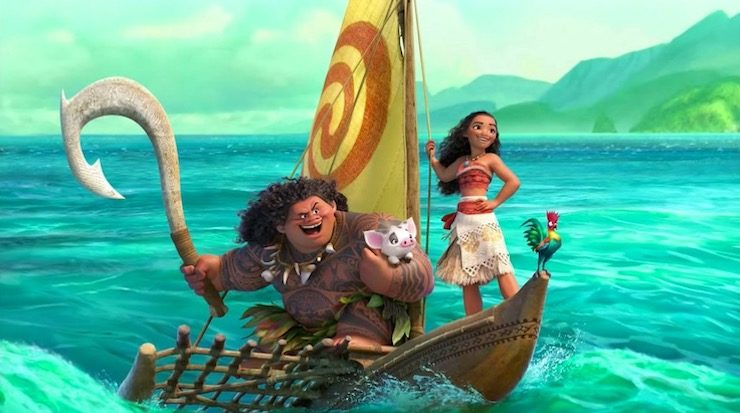
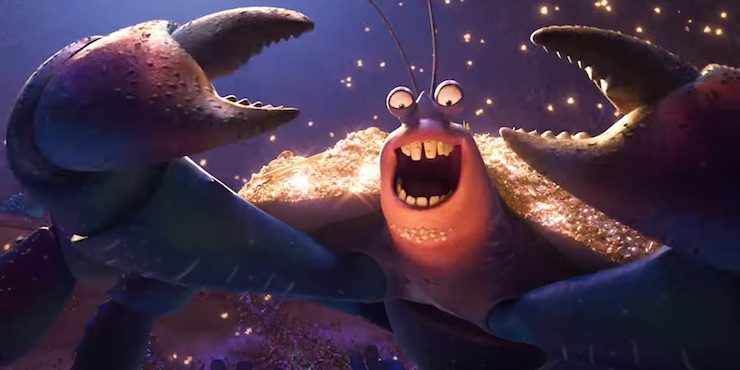
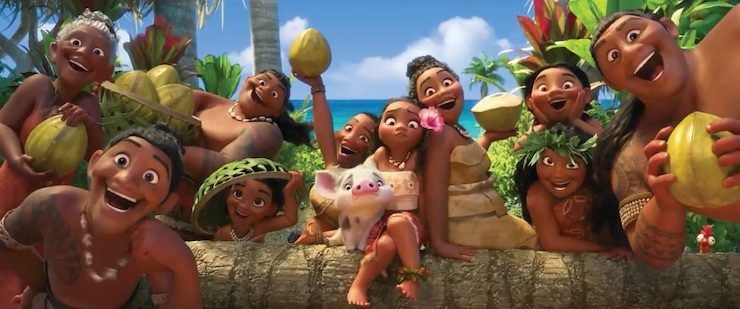
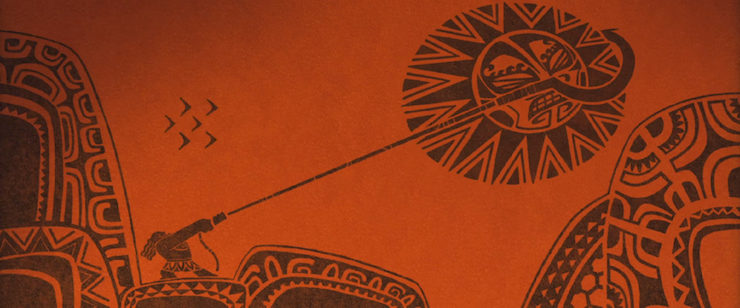
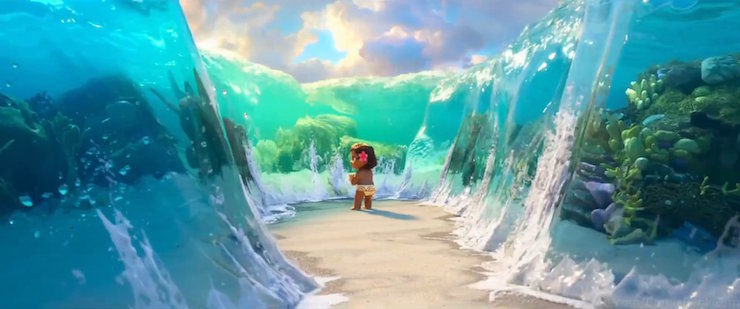
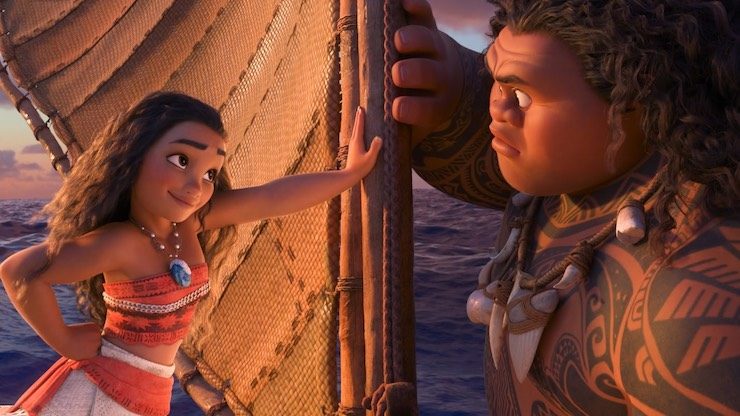
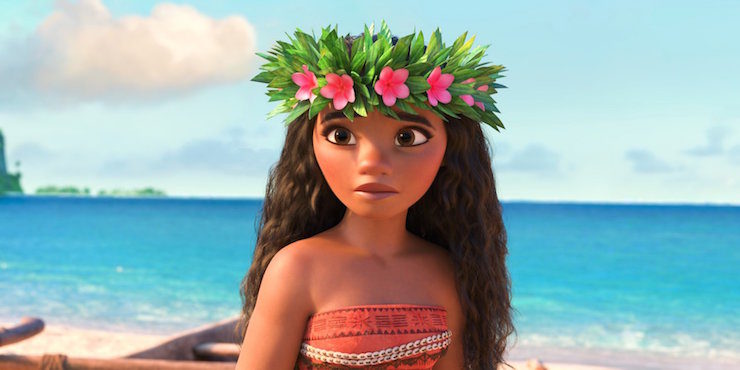
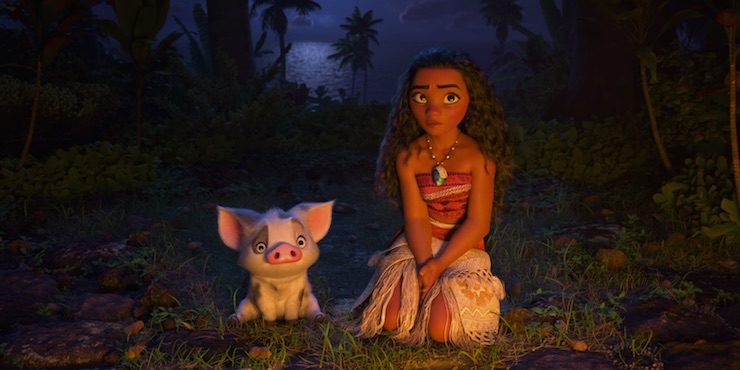
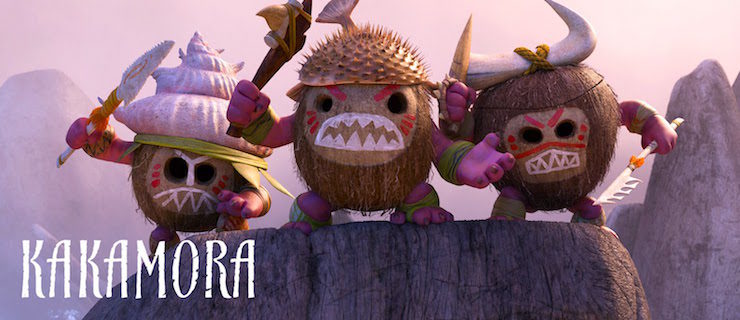
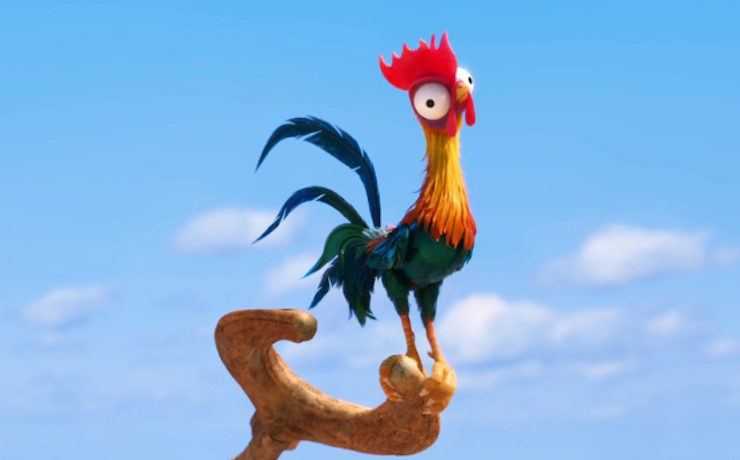
Well Mari thanks for all the hard work on this re-watch. I enjoyed the background and details you gave for each film. Great job I look forward to the next project. I haven’t seen Moana yet but will probably try to fit it in during my vacation.
They’ve already started the Walt Disney Signature Edition line with Snow White and the Seven Dwarfs, Beauty and the Beast, and coming soon, Pinocchio.
Most native cultures, apparently including the various South Pacific cultures, weren’t exactly poster children for the environment. They trashed the environment they were in and moved on to a new location.
To expect our ideas of the environment to be superimposed over that reality is silly and condescending.
While I agree with you that breaking living coral is bad, and should not be done “just because you saw a princess do it”, she wasn’t exactly having fun in that scene either. It was the choice of break the coral that was holding her or drown.
The kids loved this movie. The scenes with the grandmother gave me a kick in the heart, but overall it was very enjoyable. My niece wants everything Moana, although we had a hard time getting some of the toys as they are selling out with the Christmas rush.
MByerly –
First, Moana makes no claims to be depicting “reality.” It’s not a documentary. It’s a fantasy film featuring a demigod, a sentient ocean, a demon, some coconut pirates, and a ghost.
Second, Moana superimposes a number of current American ideas on its South Pacific setting, including jokes about Disney Princesses, Twitter, and The Little Mermaid. It even has an entire sequence based on Mad Max, Fury Road, which came out just last year, in 2015. The issues it raises about resource deprivation and responses to dwindling resources are current concerns for many Americans.
So yes, I have no problem judging Moana for what it is – a contemporary American film from a company that at least claims to be interested in environmental issues and conservation practices. I’m not judging Pacific cultures here. I’m judging Disney.
I do, however, find it interesting that you’ve responded to a post about a film featuring South Pacific Islanders with a statement essentially trashing all “native” cultures, especially since you admit in that comment that this only “apparently” is true about South Pacific cultures. Hmm.
I don’t want to watch anything about someone else’s special relationship with an ocean. As a marine-biology educator, I should probably watch it someday to learn what they got wrong, but not now.
I can’t watch films in 3D either, as I wear thick glasses.
Thanks again for the fun and remarkably informative Read-Watch and Watch.
When I was raising Elle, I bought a TON of Disney Princess toys. As I matured and got more into feminist analysis, I got rather concerned, wondering if perhaps I had imparted sexist values and warped gender expectations to her.
But I’ve mostly come to terms with it. For two reasons.
One, it’s like Intro to Geekness 101. She mainly outgrew the princesses, and grew into Marvel comics. But it gave her and I a shared passion we could always bond over, and it provides a great way to have the important conversations about ethics and morality and values.
But second, it had an unintended consequence. I was raised in geekdom, but back when women we tokens(not that this a SOLVED problem, but it’s getting better). I was brainwashed with Smurfette syndrome, which gave me a lot of Exceptional Girl bullshit I had to outgrow. Plus, it screws with your perceptions, and it makes it hard to notice women and girls are discounted by a sexist society, because tokenism conditions you to expect it.
But Elle never was. Instead, her childhood fantasies centered on stories told about girls by girls. The male characters were non existent at the introduction of the series, so it didn’t introduce hetero romance into their play. The princesses were the damsels and the heroes of the stories they told, because they had to be.
And that completely changed her expectations in her media, and in her social circle. She has no patience with men and boys who can’t be genuine friends with women and girls, aside from pursuing them romantically. I am legitimately grateful that she got to experience a woman centric fantasy world during her crucial childhood development.
(Sorry I haven’t seen Moana and am avoiding spoilers, but I have a great deal of fondness for the Princess line, OBVSLY)
@MByerly
Some Pacific cultures trashed their environments, yes. Easter Island and NZ are the poster children for that. Most however didn’t have very big environments at all, and managed to eke out a stable existence on them for several centuries before the Europeans arrived and everything changed, which meant preserving what they could.
The vast majority of degradation happened in the last century as modern mining, farming and fishing techniques devastated islands.
@5 I took archeology and anthropology courses in college, mainly about North America, and I read a bunch of studies on various North American sites.
Since, I’ve read about the native cultures as well the various mythologies so I’m not trying to trash the native cultures from ignorance. They were what they were, and romanticizing them is as bad as demonizing them.
MByerly –
I, too, took archaeology and anthropology courses, not just in college, but in graduate school as part of a PhD program in history/anthropology.
What I mainly took from those courses is that it is generally highly questionable, if not flat out wrong, to extrapolate features and studies of any North American culture – Algonquin, Navajo, Disney – and assume that any of these features will necessarily apply to any given South Pacific culture.
I’ll also add that I am not attempting to romanticize any given culture. Some native American cultures did engage in destructive environmental practices. But claiming that the majority of them did so on a regular basis is, first, vastly oversimplifying a considerably more complex situation (starting with the huge fact that native American cultures ranged from populous urban centers to hunter gatherers, with necessarily different impacts on their surroundings) and second, completely irrelevant to the post, which is not about native North American cultures, but about South Pacific cultures AND 21st CENTURY DISNEY CULTURE, which, as the post and Disney itself have pointed out, is also not the same as South Pacific cultures.
I will also add that nowhere in this post did I claim that Moana accurately represents the environmental practices and beliefs of historical Pacific Islanders – even Disney isn’t trying to make that claim. Nor at any point did I attempt to romanticize Pacific Islanders, or claim that native North Americans never engaged in environmentally destructive practices.
Indeed, the only entity attempting to romanticize Pacific Islanders here is Disney, which in Moana explicitly blames environmental destruction not, as you are arguing, on the actions of native groups, but on the actions of divine beings. In other words, the only person arguing here that native groups DON’T engage in environmental destruction is, to repeat, Disney. In my post, I specifically critiqued this argument, and Disney’s decision in this film to claim that environmental destruction is caused by uncontrollable forces (magic) and can only be reversed by uncontrollable forces (magic), which, although sometimes true (see, volcanoes and tsunamis) leaves out the role that humans play in environmental destruction.
If, as you argue, romanticizing native groups is as bad as demonizing them, then the entity you should be calling “silly” and “condescending” is not me, but Disney – the one doing the romanticizing.
Meanwhile, I’ll point to Mayhem’s comment, which notes that South Pacific cultures varied in their approaches to the environment, with some cultures practicing destructive environmental methods and other cultures practicing more sustainable methods. In this sense only, this sounds very similar to native North American cultures – with some practicing destructive methods and others practicing more sustainable messages.
That said, given that the interactions of all cultures with their environments is an incredibly complex subject – and, incidentally, another thing I studied in graduate school when I headed back for the second time, to study marine biology and marine environmental science – I think we all might be better off chatting about the film and that rooster.
Jay D – Well, maybe this means we’ll finally get the package films in the correct aspect ratios, too late for me to comment on them!
Browncoatjason – Which is why people should be very careful around reefs to not get in that situation!
AeronaGreenjoy – Except for the glam crab, most of the marine life depicted is pretty vague. So apart from that, and people talking to the ocean and the ocean grabbing people and swinging them around, I don’t think you’ll find anything too inaccurate.
Aeryl – That’s an interesting take on Disney Princesses, thanks!
I loved Moana! It was fantastic and I’m looking for an excuse to go watch it again (usually I don’t…budgets and all that). There was very little I didn’t like. Even the bizarro glam crab was fantastic, if non sequitar, imo.
I really do not get how people see Maui as “fat.” From the moment I saw him all I saw was epic muscle, and an obvious animation caricature/silhouette of the beefier body type of many athletic Pacific Islanders. Nothing even wiggles on this guy, other than his pecs, lol.
Thanks for agreeing to do the “second half” of the Read-Watch, Mari! It has honestly been the only Tor article series to date that I have looked forward to and read immediately each time. I will definitely look forward to any other articles you do. :)
I have to admit, learning about Temuera Morrison’s presence in the making of this film has given it some credibility in my mind. I’d learnt all about Disney’s romanticising of pre-Contact non-European cultures courtesy of a quartet of Disney books my parents got for my siblings and me; it had a number of stories on the First Nations, and the Winning of the West, including a story called Tonka Wakan. At least they didn’t romanticise Custer but let him stand on his own two feet as a jerk.
(You must’ve heard of Jake the Muss? It’s Temuera Morrison’s role in Once Were Warriors!)
And who in Polynesian myth is Moana based on? I doubt it’s Maui’s sister Hinauri, who married Irawaru, who Maui in a fit of rage turned into the first dog.
@MariCats – “In my post, I specifically critiqued this argument, and Disney’s decision in this film to claim that environmental destruction is caused by uncontrollable forces (magic) and can only be reversed by uncontrollable forces (magic), which, although sometimes true (see, volcanoes and tsunamis) leaves out the role that humans play in environmental destruction.”
I’m not really seeing this – and I agree with the previous commenter about the Coral btw, the fact that Moana was about to die because she was stuck in it is a meaningful component to that scene. Its not as if she went around breaking coral habitually whenever she was bored.
In this particular situation, this is a world in which magic is real. There are demigods and monsters. It is not our world. There was a magical attack, by Maui, on Te Feti, which (unintentionally as it turned out) created a vengeful monster that’s wrecking the world. That was clear from the opening scene.
In this world, the resource problems that they’re having are indeed and in fact purely a delayed result of the attack. Correcting that situation didn’t solve a natural problem with magic, it addressed a magical problem with magic.
Remember too that when the attack first spread to Moana’s island, the initial responses were all very reasonable (rotate the fields, fish from the other side of the island, etc) which also showed that they were not in fact currently using all of the available natural resources on the island.
…
Mildly changing the subject, have you listened to the full soundtrack? The second disk contains some wonderful demo tracks sung by Lin-Manuel that cover songs pulled from the movie (but you can have fun seeing how they grew into the ones we have) and first cuts of Where You Are, Shiny, and You’re Welcome (again with just him on the vocals, and a chintzy drum machine backing up on Shiny).
I don’t follow the trivia btw, but did anyone else wonder if they’d written Shiny hoping to get Bowie to play the part of Tamatoa?
@@@@@Aladdin_Sane – apparently the myth is original Disney, based on the writers imagination about what could have caused the very real 1000 years or so without much voyaging between the islands.
@MariCats
I’m with @RJStanford and @BrowncoatJayson on the coral side of things. She wasn’t going out to destroy living coral, the choice was break it, or drown. She wasn’t breaking off a piece to take home with her. I would be surprised if anyone took home the message that it was okay to go out and destroy coral from that scene. When I was living in Hawai’i and surfing there, I got raked over coral by waves several times. It was incredibly painful, and I have no doubt that I caused some to coral to be damaged, but that wasn’t my purpose out there, and I wasn’t going and standing on the reefs being ignorant like many of the tourists that would snorkel on the reefs. All that said, if my leg had gotten stuck between coral, you can bet that I would have broken it to continue living instead of sacrificing my life for the coral.
Hmm. I took different things away from some of it, I think. For one, I didn’t really get the idea that exploiting other islands was presented as the solution to environmental destruction. Moana needed to leave to save the island, yes, but because she needed to leave to find the true solution to the mystery/tragedy of Te Fiti. When the whole tribe took up voyaging again, I felt like it was more to trade and/or to satisfy their intellectual curiosity. The lyrics talk about how they’re going to go back home after their voyages, not stay and settle on these other islands.
There’s one myth of Maui and Hina, btw, that bears some similarities to the backstory of Maui trying to steal Te Fiti’s heart to win immortality for people. The particulars are quite different, but then, I don’t think you could put the original in a Disney movie.
(And then the Fridge Brilliance of this movie, to me, was when I realized, like an hour after leaving the theater, why the ocean didn’t just take the heart to Te Fiti like Maui asked. Because it couldn’t, which is a clue to her current status. It needed an intermediary.)
The songs may not be as immediately earwormy as other classics, but they’ve grown on me over time.
That may be because Lin Manuel Miranda’s lyrics are more complex, so it can take a couple listens before getting all the words.
By now, I think I’ve had almost every song looping through my head at some point (currently stuck on “Shiny”).
Oh, Mari, in a christmas related Disney thing.
Have you ever heard of Kalle Anka in Sweden? Apparently the entire country stops and watches classic Disney cartoons every year on Christmas Eve.
As in, even A&E attendance drops by 90% for that three hour period.
FWIW, in relation to Polynesians and the Pacific, the Moriori of the Chatham Islands, NZ, established a strict No-War regime amongst the clans that kept the peace for several hundred years. Considering that most fighting occurs amongst young men, to be able to stop fighting when first blood had been drawn and consider the matter settled, calls for quite a bit of self-control. Compare that to Easter Island – certain common human characteristics lead to disaster; certain others are much rarer, but don’t lead to disaster.
Wouldn’t the Disney princess who loves the status quo be Kuzco?
RJStanford:At least one actual Polynesian critic has pointed out they didn’t *stop* trave;ling in that 1000-year gap. They continued trade and travel among established islands, consolidated holdings, refined and improved navigation techniques, and when a turn in the weather that was helpful for long-range navigation came about at the right time (probably a combination of those improved techniques and population surplus), they took advantage to explore new territory again. Disney’s portrayal is of a stagnant era, at least for its Ruritania-Island.
_______
i love this movie already in almost every way (caveats for the Disneyfication of actual cultures and living mythology, though I feel this was more respectful than Pocahontas or Hercules), including the music, and I think it’s going to have lasting worth myself, but it pretty much perfectly hits a lot of buttons for me. (not enough lizards on the island*) so i make no claims to reasonable objectivity.
I did find it was continuing the established trend of playing with and mocking Disney’s own tropes – the pig is cute, and you assume he’ll be the animal companion for the duration, but he never leaves the island. The argument about whether Moana is a princess (As far as the Disney Princess merchandise line goes, she’s as much of one, or more, than Belle or especially Mulan, who doesn’t even have Belle’s “likely marriage to a prince in some vague future date” to push her into the franchise). There’s at least one crack about not bursting into song. Moana’s essential skill is neither the overly feminine love and understanding and homekeeping, a la Belle or Snow White, nor the explicitly unfeminine warrrioring. She wants something more and different, but it turns out the more she wants is ALSO part of her granted heritage and accepted tradition (Thus unifying the two things tearing her apart at the beginning). The lack of romance might not be new but it continues to be refreshing, and indeed even Brave (And the Emperor’s New Groove) insist on making a reference to the “need to marry”, even if the choice in both cases is obviously “Later”.
Mari Ness, I have enjoyed this entire run of movie commentary. This was a fine series. Thanks.
*When I was 9 we did some travelling, and my formative experiences of Fiji included coral reef ringing the island we were on, other islands close enough for a good swimmer (not me) to visit, the buoyancy of salt water, smiling dark-skinned people who seemed happy to be friendly to a little white girl (Caveat being, it was their job and I was a clueless kid about how that affects interactions, but I did bond with one elderly island lady), pineapple available at breakfast and lunch every day (this was a good thing for the duration), the hollow drums in the style of the one in the movie, and lizards too small to eat running away underfoot on any path not trodden by another person in the last several seconds.
I just got around to seeing this today, and enjoyed it greatly. I think my favorite feature was the fact that Moana is the chief’s daughter, therefore she’s next in line to be chief, and nobody bats an eye at that. There’s no worrying about why her parents didn’t have a son, and even better, there’s no indication that she was thrust into that situation unprepared. Her father was clearly preparing her for her responsibilities from day one.
From the “pure fun” perspective, wow, the graphics on that shiny crab, huh? I’ve gotten beyond thinking “hey, that’s really great water” (two Nemo films will do that), but the neon glow, combined with an amazing song that begged to be performed by David Bowie, blew me away.
Thanks so much for extending the read/watch to the Disney originals, Mari. I learned a lot about Disney history that I never knew before, and it’s fascinating. I can’t wait to see what comes next.
@Mayhem, lumping NZ in with Easter Island as destroying their environments is a little unfair. While the arrival of Maori caused significant environmental harm, including the extinction of Moa and giant Eagle, at the time of European arrival NZ supported complex societies with environmental regulation as an important part of it. Of course Maori were not noble savages at one with the environment, but neither was NZ a country environmentally destroyed.
@Aladdin-sane, surely you’ve forgotten Tem Morrisson’s most iconic role, Dr Ropata.
I finally saw Moana yesterday, and liked it very much. Loved the look of it: the water, the animate tattoos, the coconut pirates, the spirit-ray, the shiny crab’s place. I’ve never loved the look of a CGI-animated movie quite so much. (The animate tattoos being hand-drawn no doubt helps.) I’m glad the Chosen One is now sometimes female in contemporary works of lit & art, and glad that Disney has gotten gradually better at how it portrays its female leads (independence of mind, degree of need to find oneself through romance, body type, etc.).
While lots of people were involved in the writing, I thought the plot was quite coherent. I’m more positive than Mari on Dwayne Johnson’s singing–I thought he did a fine job in getting across complex lyrics, and used inflection well to communicate character and humor. (I agree, mirana @11, Maui doesn’t look fat at all to me–all muscle, and as Mari says he needed a large body to provide a canvas.) His readings and the animators’ art manage to make the narcissistic Maui likeable even before you learn his reasons for craving applause and before he grows into more responsibility.
I don’t share Mari’s uneasiness about the “magic fix for environmental problems” aspect. I agree with RJStanford @13 that in this story the problem itself is caused by magic or supernatural elements. I suppose I would say that the supernatural elements are symbolic ways of talking about the threat to the environment. Symbolically, we have torn the heart out of the earth, and degraded or destroyed its capacity to renew itself. Symbolically, we have to return the heart to the earth, and let it recover its capacity to renew itself. Nature (the earth & ocean) can’t do this without human cooperation; the sea needed not only the (originally human) demigod but also the human to reverse the harm done. I think that’s a fine message, in symbolic/narrative form. Often we do destroy the environment in the process of trying to wrest from it the power to make or do, to claim that power for ourselves over against the natural world, e.g. using fossil fuels to power our industry, transportation and indoor climate control. So the story of stealing Te Fiti’s heart in an attempt to take control of life-giving power works for me to represent our assault on the environment.
I thought the script was positive about the practical approaches Moana suggests of planting trees in another spot etc.–they just weren’t enough by themselves. The whole system is awry, and the whole system needs to be healed/freed/restored. Symbolically. I also agree with Kelly L that they’re not heading off at the end to environmentally exploit and degrade another island. Their own island’s environment has been (or is being) restored, and they will come back to it.
I have hugely enjoyed the Disney Read/Watch, thank you, thank you! I have enjoyed other posts you’ve done in the past, Mari, and will follow whatever you do on Tor.com in the future.
I thought Moana was absolutely fantastic. The animation was top-notch, and the songs didn’t leave me wanting to brain myself with a hammer. (A month later, I’m still humming “Shiny” in my best David Bowie voice.)
Like a couple of other commenters, I didn’t think that the point of the islanders’ reaction to the ongoing food crisis was to despoil other islands. It was, rather, stubborn fanaticism and passivity in the face of possible disaster. Never leave the island, goes the idea; the Goddess will save us. It is true that Te Fiti did eventually save the islanders, but only through the the courageous actions of her unwitting emissary. In fact, it was only after they had been saved that the islanders realized that their lives had become stagnant and ossified.
Best movie of 2016, among my limited viewing. I may have to watch again, but I thought when Moana suggested trying the environmentally friendly fishing methods you’re describing (a different side of the island, etc) the fishermen weren’t dismissive; they told her they’d tried that, they’d tried everywhere, but everywhere was barren of fish all at once. Obviously it’s mysterious and not to be chalked just up to their practices, thus paying adequate lip service to human impact before enabling this story about a supernatural explanation. Also, hurray that Moana knows this stuff and suggests it, and (to my mind) apparently the fishermen know it too. In fact I think environmentalism, caring for it and working to do good in its name, is a major theme of the movie. And maybe you were avoiding spoilers in your review, but I was definitely remembering Fantasia 2000 at the end.
In fact, imho this movie knocked itself out trying to be safe and that was maybe the one thing that irked me about it (irony). Coconuts for pirates seems like a choice to avoid offending anyone. On a striving-for-political-correctness scale this movie probably rates 11 out of 10 for effort, which makes it feel a bit plastic but it’s impressive how much story they still came up with inside of those safety nets.
Finally got a chance to see this and catch up on old read-watch posts :D
I appreciated Moana’s look (she looks strong and fit, even if she’s not as thin as other princesses), her hair (amazing, amazing hair animation – I also tend to hair of a similar texture, although nowhere near so sleek and luxurious!) and spunk. I loved that there was basically no bones at all made about the fact that she’s next in line to be Chief, and I appreciated that they did not default to any sort of romance arc at all with her (although I do love romances) – I think this is notable since the movies you point out feature primarily non human protagonists. I think this might be the first time we see a human girl (outside of Brave which isn’t part of the Disney canon – but even that had a plot of her AVOIDING romance) not used as part of a romantic plot.
Now, I do think her face bore a striking resemblance to Rapunzel’s and in fact, her I Want song could maybe be described as a mashup of the various motivations of Ariel, Belle, Pocahontas and Rapunzel…but I suppose that’s pretty expected for a Disney movie.
The songs were great, the animation was great. If I have a complaint it is that the plot was not quite as meaty/clever as some recent Disney offerings like Zootopia or Wreck-It Ralph. It was a pretty standard get magical X thing, encounter monster, get magical Y thing, go to magical Z place with not really a lot of deviation from that (and I found the ‘Ocean’ at times a kind of annoying deus ex machina). But the journey itself is enjoyable, as well as both Maul and Moana learning who they are and makes them what they are.
If I wanted to nitpick I might have something to say about the Mother Island also being the villain once her heart is removed as a fairly shallow portrayal of powerful women, but since we’re talking about primeval, larger than life goddesses…it may fit.
I didn’t actually think about the environmental aspects of the film but if I recall she DOES instruct them to fish elsewhere and they had already tried that, and they do try to plant other groves. So I don’t get the impression that they were otherwise bad stewards of their environment, they were just…cursed. I’m not sure they’re saying one thing or the other about stewardship or the environment. Sometimes a curse is just a curse. I don’t think any of it is meant to be any type of statement about actual real-world environmental conditions where curses don’t apply. So yeah, it does seem weird that people are reading the film as one way or the other about the environment. (Although if I was trapped under coral and about to drown…I’d break the coral. Sorry not sorry). Also, I took the ending as them going out exploring again, not necessarily intending to spread to other islands or exploit their resources.
I also think it was interesting that the start of the movie plays Maui’s stealing of the heart to be about getting power for himself, but the movie seems to reveal that he did it to earn the love/adulation of humans (although is the implication that humans couldn’t create life before this?)
I really was not into the coconut pirates at all though (or Hei Hei). Definitely was a WTF moment for me. (I’ll be honest, I freaking loved the glam crab even though he really adds nothing at all to the movie aside an obstacle to getting the hook. And the neon animation actually reminded me a bit of Princess and the Frog.)
If anything, the big shocker of this movie is that when she comes back home, they haven’t eaten her pig…I mean, they had no fish, or coconuts so…
I’d rate this one as above average, perhaps, but probably not in the top 10. (Interesting to me that you mention Aladdin here becuase I think that despite some of the dated references it is still a classic movie that does stand the test of time.)
Now that I have read the comments, it seems like others have made similar points and I do like @24’s interpretation of the heart itself representing a kind of human abuse of the environment.
The Pratchett (three t) story they wanted to adapt was Mort. I haven’t seen Moana yet, but from what you say about it, I was hoping it was Nation they wanted to adapt.
@29 – Typo fixed, thanks!
Supernatural aspect notwithstanding, I took the environmental message mostly as “you can’t solve global problems with local solutions” and “isolationism will only take you so far.” Similarly, the explorers don’t exactly ravage the islands they visit and move on, specifically their song states that they do know how to get back to their home island, it’s just that they look beyond the boundaries of the own island.
I picked up the sound track CD a couple of days ago and since then “Shiny,” “You’re Welcome,” “How Far I’ll Go,” “All you need” and “Know the Way” have been alternately bouncing around my head, with “Know the Way” on top at the moment. I managed to get Shiny memorised in a couple of days, which is pretty quick by my standards. So as far as I’m concerned it totally out ear-worms Frozen.
RJStanford – “I don’t follow the trivia btw, but did anyone else wonder if they’d written Shiny hoping to get Bowie to play the part of Tamatoa?”
The reason “Shiny” sounds like a Bowie song is because Jemaine Clement was cast as Tamatoa. Lin-Manuel Miranda, who co-wrote the songs, has been a fan of Flight of the Conchords for many years, and FotC has a song about David Bowie called, appropriately, “Bowie.” When he learned that Clement had been cast, Miranda wrote “Shiny” as an homage to that song. David Bowie was already dead when the song was written.
Whoa, Mari, I love this review, but this
And also interestingly, Moana suggests that instead of trying new or environmentally friendly/sustainable approaches (go fish somewhere else while you let the fish stocks in the lagoon recover! plant another grove over there!), the best way to save the island environment is to return to the old methods of exploration, and find more islands to exploit.
Is just wrong, she outright tells the villagers to do this, only to be informed that they’ve already tried that with the fish. They do follow her suggestion to plant a new grove, and the farmer compliments her on how hard she’s working for her community. If the movie has ANY FLAW(this one has quickly become my absolute FAVE) it’s in that when Moana finally does leave, the movie is beholden to the fact that her motive to leave is completely about subsuming her own desire to explore the ocean. It’s never addresses the “what’s wrong with me” question, instead deflecting it by forcing Moana to defy her family for their own good(and because she was chosen by the ocean), and not because they are unfairly holding her back from her potential.
The Kaka Mora, along with the “glam crab”, are foreshadowed in the story being told by Grandmother in the opening of the movie. She is accompanying her story/history lesson with artistic depictions of these creatures as the things that moved into the sea, making it dangerous to explore, after Maui stole the heart of Te Fiti.
@RJStanford, 13
My thought was Tim Curry.
Also, @MariCats, did you notice that Maui’s hook is embedded the animal markings of all his different shapes? The hawk is the most noticeable, it can be seen is the feathers of his right underwing. As you watch the credits, they reveal the markings on the rest of the shapes.
And Temuera Morrison was first known to me as Axel from Barb Wire
I ‘ve been rereading Earthsea lately and listening to the Moana soundtrack while driving the kid, so my brain made a connection… Farthest Shore, anyone? Ocean voyage on a quest to save the world, young hero(ine) and old mentor…